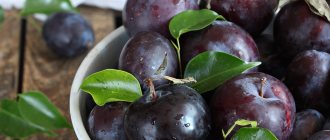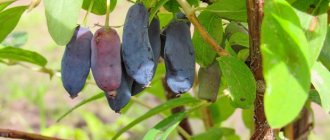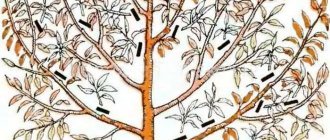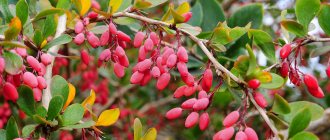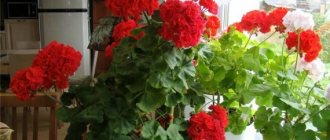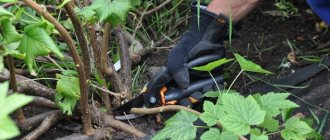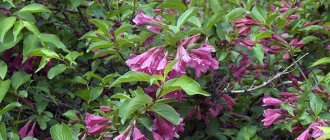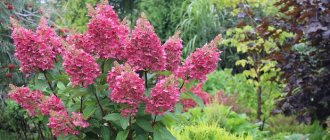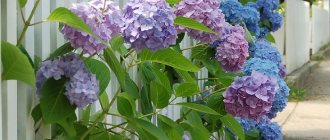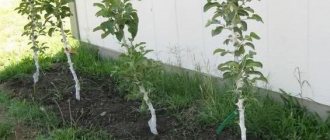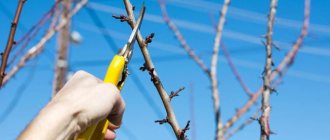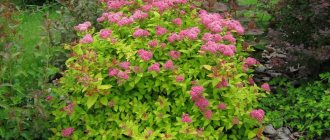Summer residents plant honeysuckle in their plots because it is unpretentious and easy to care for. Amateur flower growers plant different varieties of this plant in gardens and flower beds, but the most common are honeysuckle and Tatar honeysuckle. A good harvest depends on how you prune honeysuckle in the fall. For this purpose, deadlines are observed and the features of autumn pruning are taken into account. The berries of the bush have an unusual taste and have beneficial properties. Substances found in fruits have a positive effect on the human heart and blood vessels: they become stronger, and blood pressure normalizes.
Features of honeysuckle care in autumn
Gardeners plant several varieties of plants. One of them is a low edible shrub. Due to cross-pollination, it is necessary to grow more than 2 bushes of different varieties on the plot. This plant tolerates severe frosts well down to -35°C.
Another type of honeysuckle is a climbing shrub called honeysuckle. Over the course of several years, the plant wraps around a fence about 5 m high, creating the effect of a living green flowering hedge. These bushes do not survive winter cold so well, so they need shelter.
Despite the difference, the care required for shrubs is almost the same.
Features of cutting honeysuckle
Shrubs do not require any special care, but pruning is important to prevent the bushes from becoming overgrown. Ornamental plants are trimmed to give them a neat appearance. Edible honeysuckle is pruned in the fall to ensure a good harvest and the berries become larger and sweeter.
Important! Shrubs that are 8-9 years old are cultivated. Before this, the bush is pruned sparingly.
Main purposes of pruning
Bushes are trimmed not only for the overall aesthetics of the garden. The procedure brings benefits to the plants themselves. Thanks to her:
- shrubs become healthier because dry and diseased branches are removed;
- productivity increases;
- new shoots grow faster;
- there is more air inside the plant for ventilation and proper growth of branches;
- the bushes look neater.
The purpose of pruning depends on how old the bush is. There are several cutting systems:
- For shrubs that are one year old, all stems are cut off at the root, except for a few of the strongest ones. The tops of the shoots are also removed so that the honeysuckle grows thicker.
- For 6 years, only diseased branches of the lower part of the plant are cut out.
- Bushes that are about 8 years old are given a rejuvenating haircut. They are thinned out every 4 years.
- Old plants are completely rejuvenated. The shoots are removed, giving the bush a second life. After this, honeysuckle is formed, starting from the first stage.
Pruning is beneficial for plants. Thanks to it, the bushes become thicker and healthier.
You may be interested in:
Caring for buddleia for the winter: how to prune, insulate, features of autumn replanting. The homeland of lush flowering buddleia is China. Although this exotic plant has adapted to the harsh Russian...Read more...
When is it better to trim honeysuckle - in spring or autumn?
Honeysuckle wakes up early after winter, so cutting branches in the spring can greatly harm the plant. If you calculate the cutting time incorrectly, you can remove the fruit buds. Therefore, a better time for pruning bushes is November. They start when the temperature stays below 0°C and the leaves fall off.
Attention!
Trimming a plant ahead of schedule is dangerous because energy and nutrients are spent on bud formation. During cold weather they freeze and die.
Guide - how to prune honeysuckle
The plant does not require annual pruning like other garden shrubs. But, if autumn pruning is coming this year, then the honeysuckle will be inspected first. Depending on the quality of the previous haircut, the depth of the upcoming one is determined. If gardeners do everything correctly, then further pruning can be done after 2-3 years. The condition of the bush depends on it, so it’s better to try to do everything strictly according to the instructions:
- There is no need to remove the entire branch if only some part is damaged. Only cut off the dried or damaged part.
- The bush must have constant access to fresh air, so the lower branches that bend strongly towards the ground must be cut off.
- If the stem has no branches or shoots of an odd shape, then this branch is cut off completely.
- On skeletal stems, branches growing inward are removed. Because of them, smaller berries grow on the bush.
After cutting, from 8 to 16 shoots remain from the entire bush.
Good, healthy shrub stems can be easily broken or damaged, so branches must be removed very carefully.
You may be interested in:
Treatment of honeysuckle diseases Despite the fact that honeysuckle is a fairly unpretentious bush to grow on your own site, when...Read more...
Features of cutting old and young shrubs
The process of pruning mature and young plants is significantly different. Features of cutting young bushes:
- It is recommended not to prune recently planted honeysuckle bushes: this slows down the growth and development of the plant and prevents the formation of young buds;
- bushes that are less than 5 years old are pruned sparingly: only dried, damaged stems growing in the center. This will allow sunlight and moisture to penetrate into the shrub, promoting uniform growth.
An old bush can be rejuvenated by removing old branches or cutting the bush completely to the ground. All shoots above 35-40 cm are also disposed of. Rejuvenating haircut is carried out after the foliage has fallen. In the future, new shoots will grow.
Advice!
Experienced flower growers tie up bushes after a rejuvenating haircut. Pegs are driven into the soil along the perimeter, which are then carefully tied together with a rope. Thanks to this, the bush does not fall apart, and young shoots are protected and do not break.
Honeysuckle honeysuckle - pruning in autumn
Honeysuckle is a decorative variety of honeysuckle that entwines the fence, forming a hedge of flowering bushes. It looks beautiful, which is why landscape designers often use this flower in the garden. Honeysuckle is trimmed for rejuvenation and to give the correct direction for growth.
This honeysuckle grows very quickly. Therefore, honeysuckle is pruned in the fall, removing dried and broken shoots. Those branches that are knocked out of the fence and violate the intended design plan are also removed.
Planting honeysuckle honeysuckle in open ground
When to plant
Planting honeysuckle honeysuckle and caring for it is no more difficult than growing any other ornamental shrub. The best time to plant honeysuckle honeysuckle in the garden is April or May, although some gardeners advise planting the plant during leaf fall. When choosing a place for the plant, remember that abundant flowering can only occur in bright sunlight, although honeysuckle can tolerate partial shading. Honeysuckle honeysuckle liana loves moist, fertile soil, into which before planting it is necessary to add mineral and organic fertilizers for digging: potassium, nitrogen and rotted cow manure. Moreover, you need to dig up the soil with fertilizers at least two weeks before planting.
How to plant
Depending on your intention for planting the plant, dig a hole or trench. The size of the pit should be approximately 50x50x50 cm, and the trench should be 50 cm deep and 50 cm wide. If planting is carried out in an area where water stagnation may occur, lay a layer of drainage made of broken bricks, ceramic tiles or crushed stone at the bottom of the hole, then fill the hole almost to the top with fertile soil. Then a seedling is placed in the hole, its roots are straightened and the remaining space is filled with soil. Planting is carried out taking into account soil subsidence, so the root collar is left 5 cm above ground level. After abundant watering, the earth will settle and the neck will be flush with the surface. Once the water has been absorbed, mulch the tree trunk with organic material.
- Korostavnik: cultivation, properties and application
In a trench, honeysuckle seedlings are placed at a distance of at least 1 m from each other, and in group plantings they are placed no closer than 1.5 m. And do not forget to immediately dig in supports for the plant if you are not going to use the walls of the building or a fence for this purpose . The support for honeysuckle honeysuckle can look like a metal or wooden structure, slats with stretched cords or nets.
Rules for autumn work
Pruning is an important stage of care. Gardeners are forced to follow rules in order for the cutting process to be successful.
- Shoots that are damaged or withered are removed only after all the leaves have fallen.
- Planned work is carried out only on mature shrubs. It is better to leave young, recently planted plants alone, as infection can be introduced into the wounds.
- Old dry stems are cut off from mature bushes.
- On edible bushes, those branches that produce little fruit are removed. Overgrowth shoots are also recommended to be cut off.
- Branches that grow from below or are even pressed to the ground are pruned, because they only create a hindrance in caring for the plant.
- You cannot remove all the tops at once; honeysuckle buds form there.
- In winter, cutting off skeletal branches is not recommended. Due to removal in the cold, the entire plant freezes.
- It is necessary to carefully monitor edible varieties so that the bottom of the bush does not thin out and the middle does not thicken.
Time to trim a young bush
A honeysuckle bush is considered young if its fruiting is not yet abundant enough.
Honeysuckle moves from the preparatory stage to the period of incomplete fruiting in the third or fourth year after planting. Until this time, the honeysuckle bush is not pruned, as there is a risk of damaging the young leaf buds. If you cut off the shoots in the first 4 years, the bush will no longer form new ones, so the branches will need to be cut off at the root. Then the honeysuckle will begin the preparatory stage anew and form new basal shoots with vegetative buds. Prune 4-year-old honeysuckle in early autumn, when the bush has already dropped its leaves. Remove all root shoots that are inclined to the ground or growing horizontally. Weak thin branches, root shoots and branches growing vertically upward are also removed.
In the first year of pruning, only 4-6 skeletal branches should be left.
In this state, honeysuckle will overwinter well. To retain moisture in the soil, bushes must be mulched for the winter. Gradually the number of shoots can be increased to 14.
In different varieties of honeysuckle, the stage of incomplete fruiting can last up to 20 years.
Feeding honeysuckle
In mid-July, the bush begins to form the basis for the next harvest. Therefore, during this period the plant needs to be fed by adding organic fertilizers and mineral supplements. Ash is great for this. In dry summers, the ashes are mixed with boiling water and the resulting solution is poured over the bushes. In rainy summers, simply pour 1-2 cups onto the soil under the plant.
Important!
In summer and autumn, you should not fertilize the soil with nitrogen substances and fresh manure. This will provoke rapid growth of shoots, which die if they do not ripen before the onset of cold weather.
At the end of autumn, it is recommended to fertilize the soil with compost or humus. This gives the bush nutrients for the spring. It is better to feed decorative honeysuckle using this method once every 3 years.
Shelter for the winter
Honeysuckle is a frost-resistant plant. Its shoots can withstand fairly low temperatures. Even a flowering plant tolerates cold down to -5°C. The edible type of honeysuckle is not covered; it is cut off, fertilized and left to overwinter in the open. Ornamental varieties are not so frost-resistant to survive extreme cold. Therefore, they are removed from the fence, laid on the ground and covered with air-conducting material such as spruce branches or sawdust.
Types of trimmings
Honeysuckle crops have a long fruiting period. With proper care of the bush, it can produce a harvest for 25 to 30 years. At different periods of life, honeysuckle needs certain types of pruning:
- Formative - pruning of shoots taking into account the standard habit (reference size of the plant), carried out during the first 5 years of the perennial’s life.
- Maintenance - the procedure for removing side shoots in order to maintain its usual appearance, is carried out over the next 5 years.
- Rejuvenating - upon reaching 10 years of age, outdated shoots are cut off from the bushes onto the stump.
- Sanitary – freeing the crown from infected, damaged or dead branches and leaves with subsequent disposal.
- Planting - selection and preparation of cuttings and layering from a healthy plant for seedlings. Honeysuckle shoots are not shortened
Some of the above techniques can be used several times a year, others are strictly tied to the seasonal work schedule, and others are carried out after a set time.
Schemes and technologies of pruning taking into account stages of growth
Beginning gardeners are often afraid to trim honeysuckle so as not to further injure the bush. At the same time, the lack of proper plant care negatively affects the yield. In a thickened crown, insect pests most often breed and bacterial diseases develop.
During its life, honeysuckle goes through 3 stages of growth:
- juvenile – the initial growth phase when the seedling grows tall;
- generative – the phase of growth of the plant trunk in breadth;
- hydrocyanic – wilting phase.
The last stage is undesirable for any plant; during this period the crown becomes too heavy and thickened, the trunk breaks and rots under its weight, there are barely enough nutrients to maintain life in the drying trunks, and the harvest becomes smaller. In order to eliminate negative factors, it is necessary to trim weak and old branches in a timely manner.
Crown-forming haircut from the first year of growth to the age of five
After transplanting the seedling into open ground, gardeners begin to form the crown. To do this, choose 4-5 zero shoots growing from the soil as the main trunks. Less strong and thin branches are pruned for the tillering node. The cut areas are treated with garden varnish to avoid infection of the seedling.
The following year, overwintered specimens are inspected for the presence of new branches. Branches laid at an acute angle are removed; in the future they can provoke a break and cracks in the trunk. It is recommended to cut the longitudinal stems to the very base, because they shade the trunk and prevent crown aeration.
In one procedure, no more than 20% of the crown can be removed from the bush.
The gardener must ensure that each whorl does not contain more than 2 branches, since in an adult state, closely planted stems not only impair aeration and overload the crown, but also bear fruit poorly due to a lack of nutrients.
How to prune shrubs aged 5 to 7 years?
The maintenance pattern for pruning honeysuckle is very simple. Its goal is to avoid thickening of the crown and maintain the correct habit of the bush. The maximum size of honeysuckle should not exceed 2 m in height and 1.5 m in width. At the age of 5 to 7 years, all replacement shoots (tops) and root shoots are cut off from the bush, as they draw the maximum amount of nutrients onto themselves.
The shoots of edible honeysuckle are not shortened so as not to reduce the yield.
Faded buds are removed from some varieties of honeysuckle. This pruning is carried out after picking the berries. If necessary, remove weak and old stems inside the bush to increase aeration and better lighting.
Sanitary pruning
Sanitary pruning is not tied to calendar garden work and is carried out as needed:
- when dried shoots are detected;
- when a bush is infected;
- with mechanical deformation of the crown.
By the appearance of honeysuckle you can determine whether this bush needs pruning. Broken or shriveled branches, diseased areas of the crown, and insect infestation are grounds for sanitary work. Cleaning the crown from contaminated areas must be carried out in compliance with garden hygiene standards. To do this, gardeners will need:
- pruner;
- garden knife;
- disinfectant solution;
- gloves;
- garden pitch or resin.
Affected branches are cut to the base. The cut areas are coated with tar or varnish. When moving to a new shoot, the instrument is wiped with a disinfecting solution.
At what age does honeysuckle require rejuvenation?
Upon reaching 8-10 years of age, the shoot reduces yields and growth rates. This is due to the fact that in old, lignified trunks, metabolic processes slow down and vegetation stops. A sign of aging is the drying out and subsequent death of the tops of the branches. To rejuvenate the bush, it is necessary to trim it “on the stump”. To do this, mark 30-40 cm from the base of the bush and cut off all branches and shoots to the specified height.
Anti-aging pruning is carried out at the end of March or mid-April. The best time is autumn, when the entire structure of the bush is visible.
If you prune honeysuckle in the spring, then over the summer strong young shoots will grow from the stumps. Next season the bush will be ready for abundant fruiting.
In order not to part with the bulk of the harvest after the shrub is rejuvenated, gardeners practice gentle pruning. Old skeletal branches are cut not to the base, but to the middle, making the crown sparse. This will enable the plant to form many powerful growths in the coming season. In varieties such as Blue Bird, Azure, Cinderella, the skeletal branches bend to the soil, and the plant falls apart over time. In this case, it is better to remove the lodging growths to the base, giving the perennial a raised shape.
Cutting onto the stump of an old bush
If the plant is neglected and its age exceeds 20-25 years, then all the stems are cut to the stump, leaving 30-40 cm from the base. During the season, 30-60 new growths 35-50 cm long will form. In the second year after rejuvenation, the shrub will delight you with large berries. In the spring of the third season, thinning should be done, leaving 10-15 strong branches.
Pruning decorative and climbing honeysuckle
Cleaning the crown of climbing honeysuckle is done in the fall after the vine is exposed. To do this, the main trunk is suspended on a rope, and the side shoots are cut off under the base. Decorative honeysuckle is often used to create hedges and plant sculptures. In this case, the correction of the bush is carried out taking into account the aesthetic preferences of the owner of the personal plot.
Monitoring the condition of honeysuckle, regardless of its shape, begins from the moment it is transplanted into open ground. This is due to the high vegetative performance of the plant.
Varieties of honeysuckle honeysuckle
Honeysuckle honeysuckle has two decorative forms:
- alba - a plant that blooms with white flowers two weeks earlier than the main species;
- pauciflora is a very attractive plant, blooming with pink-red flowers, but not as profusely as the typical form of Honeysuckle and Honeysuckle Alba.
There is also honeysuckle Inga honeysuckle with white, pink, red or yellow fragrant flowers, collected in spicate or capitate inflorescences.
As for such crops often mentioned in the specialized literature as Brown's honeysuckle and climbing honeysuckle, the first plant has nothing to do with honeysuckle: it is a hybrid between rough honeysuckle and evergreen honeysuckle. Hybrid plants also include American honeysuckle and Heckrotta. And climbing honeysuckle, or German honeysuckle, is an independent species of the genus, like honeysuckle honeysuckle and honeysuckle gray-ashy, yellow, glaucous, scion, blanket, Ledebura, common, Tatar and others.
Cuttings of honeysuckle honeysuckle
Propagation of honeysuckle honeysuckle by cuttings also gives good results. Cuttings with at least two internodes are cut from the middle part of the shoots after flowering. When planting, one internode is completely buried in the substrate, having previously removed the leaf from it, and on the upper part of the cutting the leaves are only shortened. Rooting occurs in a bright place, protected from direct sunlight, and in a humid environment. It is best to root cuttings in a greenhouse or greenhouse under a film. The substrate should be light and fertile, such as a mixture of sand and peat in equal parts.
The cuttings are watered, weeded, ventilated, the soil around them is loosened, and as soon as new leaves begin to form on them, the cutting process can be considered successfully completed. The cuttings are planted in a permanent place after a year, and after another year the seedlings will bloom.
Reproduction of honeysuckle honeysuckle by layering
This is the easiest and most reliable way to propagate honeysuckle. In the spring, a flexible vine branch is placed in a shallow trench, leaving the top above the surface, the shoot is secured in the recess and covered with fertile soil. All summer the cuttings are watered and fed, and in the fall they are separated from the bush and transplanted to a permanent place.
Propagation of honeysuckle honeysuckle by seeds
Generative propagation of honeysuckle is a labor-intensive process, so gardeners usually resort to more reliable and faster vegetative methods. However, in certain cases, seed propagation is preferable to vegetative propagation. How to propagate honeysuckle honeysuckle from seeds? Stratified for two months at temperatures from 0 to 5 ºC, the seeds are sown in March in a moist mixture of equal parts of sand, peat and humus, sprinkled with a thin layer of sand on top and covered with plastic film or glass. Keep the crops in a bright, warm place, removing the film daily for ventilation and, if necessary, to moisten the substrate. The grown seedlings are promptly planted in separate pots. They are planted in open ground only next spring, and they will bloom in the third or fourth year. Until then, the seedlings need to be covered for the winter with peat, spruce branches or lutrasil.
You can sow honeysuckle honeysuckle directly into the ground, and it is better to do this in the fall, so that the seeds undergo natural stratification in the soil over the winter months. In the spring, the seedlings will sprout together. It’s easy to care for them: water them, loosen the soil around them, remove weeds, feed them, and most importantly, plant them in time so that they don’t interfere with each other’s development.
Diseases and pests of honeysuckle honeysuckle
Despite the fact that honeysuckle honeysuckle is almost not affected by diseases and pests, it still has enemies: aphids and cabbage caterpillars can cause trouble for insects, and rust and powdery mildew can cause trouble for fungal infections. Since honeysuckle honeysuckle berries are not suitable for food, feel free to use chemical means of protection in the fight against pests and diseases. For example, acaricidal preparations Actellik, Aktara, Biotlin, Akarin or Antitlin will help you get rid of aphids, and insecticides are used to get rid of caterpillars. As for fungal diseases, they happen not only due to poor care, but also for reasons beyond your control. The gardener’s task is to take measures to eliminate the infection as quickly as possible, and fungicidal preparations, which can be easily purchased at any garden pavilion or flower shop, will help you with this.
Why are rehabilitation measures needed?
The process of trimming bushes is a stressful event for honeysuckle. Therefore, gardeners remove the stems very carefully so as not to harm the plant. It is not recommended to cut off skeletal branches, since the bush then takes a long time to return to normal.
All cut areas are coated with oil-based paint or garden varnish. For additional care, fertilize the soil with compost or humus. Mineral fertilizers are added very carefully. If you accidentally increase the dosage, the leaves will grow faster and thicker, and there will be practically no flowers. Bushes require feeding with substances containing potassium and phosphorus approximately once every 4 years. In order not to forget when the last entry was made, it is advisable to keep a journal where all information on plants is entered.
Why is circumcision performed?
Experts recommend starting to form a tree at the age of five. It must be produced for the following purposes:
- rejuvenate the bush and enable the formation of new shoots;
- thin out the crown, thereby increasing the amount of sunlight allowed;
- for sanitary purposes, to remove dried and non-viable branches.
To obtain abundant fruiting, it is necessary not only to prune honeysuckle, but also to know when and how to do it correctly. The process depends on the intended goal, so rejuvenation is carried out once every three years. To form a crown, they get rid of density and young unnecessary growth. And for health purposes, old and stunted branches are removed.
How to rejuvenate a honeysuckle bush
Anti-aging pruning is carried out after 8 years from the date of planting. The plant is trimmed according to a certain pattern:
- The crown inside the bush is thinned out.
- Branches that have stopped growing are cut off as close to the base as possible.
- The young central stems are left behind.
When the old branches make up 70% or more, all the tops of the shoots are cut off. But there is also a slightly tougher method, which is used only in extreme cases, if the bush is very thick, begins to hurt, or is covered with moss.
- All old stems are cut to the ground.
- They form a bush from young growing shoots.
Attention!
If the bush falls apart, it is trimmed in the same way.
On edible bushes, berries form at the tops. Annual branches are not shortened because this reduces the yield.
How to trim?
A dense bush does not allow you to get a good harvest of berries due to poor lighting. Berries deprived of sun grow small and sour. Bees are unable to penetrate deep into the bush and pollinate all the flowers. It is necessary to thin out the branches regularly.
After planting a seedling, the plant will develop slowly over several years. We will prune honeysuckle according to its age.
Honeysuckle pruning scheme:
- Shortening the seedling. We prune before planting in the ground if the root system is damaged. We shorten the shoots by 1/3.
- Sanitary pruning. We carry out this in the spring, as needed; Honeysuckle is frost-resistant, but its shoots can freeze and break under the weight of snow. We remove all dried, damaged and diseased branches.
- Detailed. It lasts throughout the entire growing season. We remove all thin, dried branches. Honeysuckle is characterized by the presence of a huge number of small dried branches with underdeveloped buds. They are easily distinguished by the gray color of their bark; Removing dead branches will create better conditions for healthy shoots to develop.
- Formative. For shrubs older than 3 years, every 2 - 3 years. We cut old thick branches in the central part of the bush to the point of growth of the side shoot, remove shoots growing inside the bush, cut out weak shoots, shorten shoots with small increments, remove branches creeping along the ground.
- Partial rejuvenating. For shrubs older than 7 years, every 5 years. During partial rejuvenation, the trunks are selectively cut out, leaving a stump several centimeters high; no more than 5 skeletal branches should remain in the bush.
- Radical rejuvenating. For a neglected bush over 15 years old. Honeysuckle shoots are completely cut off at a height of 30 to 50 cm from the ground; It will take 2 years for a new bush to form.
When starting pruning, keep in mind that:
- Basically, flower buds are located at the ends of the shoots. Total pruning will lead to a significant reduction in yield. Fruiting will be partially restored in the second year after pruning.
- Dormant buds are located in the branching of skeletal branches. For normal crown renewal, skeletal branches should not be cut down to the base.
- The shoots that grow intensively from dormant buds in the year of pruning can reach 70 cm. Until they become woody, it is advisable to create support for the shoots. Pegs are driven in around the bush and the rope is pulled above the cut level.
Digging up the earth
The root system of honeysuckle is located in the upper layers of the soil, so you cannot dig the soil too deeply. The largest loosening depth is 7 cm. Pests avoid bushes, so fallen leaves can be left lying on the ground. After overheating, they serve as a separate source of nutrients for the plant.
You may be interested in:
How to care for blackberries in the fall so that there is a good harvest Blackberries are superior to raspberries in yield, the taste also seems brighter to demanding gourmets, but their popularity...Read more...
Features of preparing bushes for winter in different regions
Preparing honeysuckle for winter cold differs depending on what variety is growing in the garden and in what part of the country the plant is planted. Even the thickness of the fertilizing layer is different. In the northern regions, bushes are covered not only to protect against severe cold, but also for safety from birds and mice.
- Middle lane. In the Moscow region, edible varieties can be left uncovered for the winter. But decorative varieties and honeysuckle must be covered with mulch, because they are not so frost-resistant.
- Volga region. In this region, shrubs are prepared for wintering according to the same rules as in the Moscow region.
- Ural. Decorative varieties must be covered with mulch according to standard instructions. But you need to monitor the amount of snow covering the bush. If the layer is not enough, add more snow on top of the plant.
- Siberia. In the northern parts of the country, large amounts of snow fall, which can break the bushes. To keep the branches intact, they are connected into one bundle. Shrubs are protected from hungry birds using a net. To prevent mice from damaging the honeysuckle, poisonous bait is placed in several places.
Scheme for autumn pruning of honeysuckle
Next, I present 2 popular honeysuckle pruning schemes - one rejuvenating, the second detailed for fruit-bearing plants.
Leave your comments, feedback and additions in the comments. Honeysuckle has not yet been planted on our site, so I would like to see specific additions to the rules for autumn pruning.
© Ilya Vladimirovich
| 2017-08-09 Amateur gardener
Mistakes when caring for bushes and preparing them for winter
Gardeners make mistakes when caring for bushes, and sometimes they don’t even understand what they did wrong. List of typical mistakes:
- Trimming a young plant that was recently planted.
- Pruning a large number of young shoots from which buds form.
- Carrying out full deep pruning of shrubs that have not yet reached maturity. The plant weakens and loses its harvest.
- No tying of the bush after a rejuvenating haircut. As a result, the shoots are strongly pressed against the soil or damaged by the wind.
- Cutting off excess length of young shoots, when the buds are also removed.
Tips for summer residents
Honeysuckle care can be made easier by following these tips:
- The pruning process is stressful for plants, so the bushes are fed with organic matter. It can be compost or humus. For 1 bush use 1 bucket. Phosphorus-potassium substances can also be used, but be careful with them.
- Honeysuckle has cross-pollination, so be sure to plant several varieties side by side. Then the harvest is large.
- If the summer is hot and sunny, then the berries grow sweet. The best option for the plant is to be in the sun in the first half of the day. Being under the scorching rays of the sun all day will also not lead to anything good: the berries will be very small.
- If the berries are bitter, there are two reasons. Either this is such a variety, or the weather is sunny and warm, and the bushes do not receive enough moisture.
Important!
For those who use the lunar calendar, it is recommended to prune bushes from 4 days after the full moon to the new moon.
